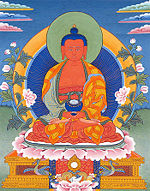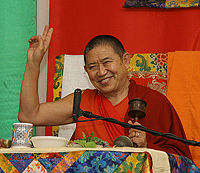Amidism/Pure Land Buddhism
From Buddha World
Pure Land Buddhism, also sometimes referred to as Amidism, is a broad branch of Mahayana Buddhism and currently one of the most popular schools of Buddhism in East Asia, along with Chán (Zen). In Chinese Buddhism, most monks practise it in combination with Chán or other practices. It is a devotional or "faith"-oriented branch of Buddhism focused on Amitābha Buddha. Pure Land Buddhism is often found within Mahayana Buddhist practices such as the Chinese Tiantai school, or Japanese Shingon Buddhism. However, Pure Land Buddhism is also an independent school as seen in the Japanese Jōdo Shū and Jōdo Shinshū schools. There is not one school of Pure Land Buddhism per se; rather it is a large subset of the Mahayana branch of Buddhism. One key concept behind Pure Land Buddhism is that Nirvana has become increasingly difficult to obtain through meditative practices. Pure Land Buddhism teaches that only through devotion to Amitābha Buddha and looking towards Amida Buddha for guidance can one be reborn in the Pure Land, a perfect heavenly abode in which enlightenment is guaranteed. Pure Land Buddhism was popular among commoners and monastics as it provided a straightforward way of expressing faith as a Buddhist. In medieval Japan it was also popular among those on the outskirts of society, such as prostitutes and social outcasts who, though often denied spiritual services in society, could find a form of religious practice in the worship of Buddha Amitābha.
Overview
Pure Land Buddhism is based on the Pure Land sutras, first brought to China as early as 148 CE, when the Parthian monk An Shigao began translating sutras into Chinese at the White Horse Temple in the imperial capital of Luòyáng, during the Hàn dynasty. The Kushan monk Lokakśema, who arrived in Luòyáng two decades after An Shigao, is often attributed with the earliest translations of the core sutras of Pure Land Buddhism. These sutras describe Amitābha and his heaven-like Pure Land, called Sukhāvatī.
Although Amitabha was mentioned or featured in a number of Buddhist sutras, the Larger Sutra of Immeasurable Life is often considered the most important and definitive. In this sutra, the Buddha describes to his assistant, Ananda, how Amitabha, as an advanced monk named Dharmakara, made a great series of vows to save all beings, and through his great merit, created a realm called the Land of Bliss (Sukhavati). This paradise would later come to be known as the Pure Land in Chinese translation. Pure Land Buddhism played a small role in early Indian Buddhism, particularly the Mahayana branch, but first became prominent with the founding of a monastery upon the top of Mount Lushan by Hui-yuan in 402. It quickly spread throughout China and was systematised by a series of elite monastic thinkers, namely Tanluan, Daochuo, Shandao, and others. The religious movement spread to Japan and slowly grew in prominence. Hōnen (1133–1212) established Pure Land Buddhism as an independent sect in Japan, known as Jōdo Shu. Today Pure Land is, together with Chan (Zen), the dominant form of Buddhism in China, Korea, Japan, Taiwan, and Vietnam. Contemporary Pure Land traditions see Amitabha preaching the Dharma in his buddha-field (Sanskrit: buddhakṣetra), called the "Pure Land" or "Western Pureland", a region offering respite from karmic transmigration. The Vietnamese also use the term Tây Phương Cực Lạc for "Western Land of Bliss", or more accurately, "Western Paradise". In such traditions, entering the Pure Land is popularly perceived as equivalent to the attainment of enlightenment. After practitioners attain enlightenment in the Pure Land, they have the choice of becoming a Buddha and entering nirvana or returning to any of the six realms as bodhisattvas to help all living beings in samsara. Thus, adherents believe that Amitabha Buddha provided an alternate practice towards attaining enlightenment: the Pure Land. In Pure Land Buddhist thought, Enlightenment is difficult to obtain without the assistance of Amitabha Buddha, since people are now living in a degenerate era, known as the Age of Dharma Decline. Instead of solitary meditative work toward enlightenment, Pure Land Buddhism teaches that devotion to Amitabha leads one to the Pure Land, where enlightenment can be more easily attained. In medieval East Asian culture, this belief was particularly popular among peasants and individuals who were considered "impure", such as hunters, fishermen, those who tan hides, prostitutes and so on. Pure Land Buddhism provided a way to practice Buddhism for those who were not capable of practicing other forms. In fact, in the Larger Sutra of Immeasurable Life the Amitabha Buddha makes 48 vows, and the 18th Vow states that Amitabha will grant rebirth to his Pure Land anyone who can recite his name as little as 10 times.
The Pure Land
The Pure Land is described in the Limitless Life Sutra as a land of beauty that surpasses all other realms. More importantly for the Pure Land practitioner, once one has been "born" into this land (birth occurs painlessly through lotus flowers), one will never again be reborn. In the Pure Land one will be personally instructed by Amitabha Buddha and numerous Bodhisattvas until one reaches full and complete enlightenment. In effect, being born into the Pure Land is akin to achieving enlightenment, through escaping samsara, the Buddhist concept of "the wheel of birth and death."
Pure Land Practice
Practitioners believe that chanting Amitābha Buddha's name, or the nianfo, during their current life allows them, at this life's end, to be received with their karma by Amitābha Buddha. The simplicity of this form of veneration has contributed greatly to its popularity throughout East Asia. This practice is called nembutsu in Japanese, or Buddha recitation, or "Being Mindful of the Buddha." An alternate practise found in Pure Land Buddhism is meditation or contemplation of Amitābha or his Pure Land. The basis for this is found in the Contemplation Sutra, where The Buddha describes to Queen Vaidehi what Amitābha looks like and how to meditate upon him. Visualization practises for Amitābha are more popular among esoteric Buddhist sects, such as Japanese Shingon Buddhism, while the nianfo is more popular among lay followers. Some have claimed there is evidence of dying people going to the pure land, such as: Knowing the time of death - some prepare by bathing and chanting the nianfo. The "three saints in the west" (Amitābha Buddha and the two bodhisattvas, Avalokiteśvara on his right and Mahāsthāmaprāpta on his left), appear and welcome the dying person. Visions of other buddhas or bodhisttvas are disregarded as they may be bad spirits disguising themselves, attempting to stop the person from entering the Pure Land. Leave sariras after cremation. Relatives or friends may dream of the dying person. The last part of the body to become cold is the top of the head (fontanel). In Buddhist teaching, souls who enter the Pure Land leave the body through the fontanel at the top of the skull. Hence, this part of the body stays warmer longer than the rest of the body. The Ba shi gui ju bu zhu, reads: "to birth in saints the last body temperature in top of head, to deva in eyes, to human in heart, to hungry ghosts in belly, to animals in knee cap, to the hells-realm in sole of feet." The dying person may demonstrate some, but not necessarily all, of these evidences. For example, their facial expression may be happy, but they may not demonstrate other signs, such as sarira and dreams.
Eastern Pure Land
In esoteric Vajrayāna Buddhism, Amitābha's Western Pure Land (Sukhāvatī) is the counterpart to Akṣobhya's Eastern Pure Land, or Abhirati. While especially recognized by the Japanese Shingon sect, Eastern Pure Land Buddhism is less popular than Western Pure Land Buddhism.


 Русский
Русский
